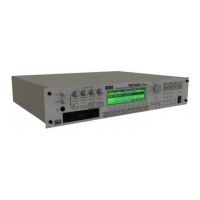66
• When Beat or Measure are selected, pattern playback
will begin when you press the first key. The second and
subsequent patterns that are triggered from the
keyboard will synchronize to the pattern that was
started by the first key; with a setting of Beat they will
synchronize in steps of a beat, and with a setting of
Measure they will synchronize in steps of a measure.
• Beat, Measure, and ARP (SEQ) will cause the pattern to
start immediately if you play the key within a thirty-
second note of the timing of the respective beat or
measure, but if you play the key later than this, the start
of the pattern will be delayed by a beat.
Stopping playback of a RPPR pattern
By playing C2 or a lower note on the keyboard of a con-
nected MIDI device, you can stop all patterns currently
being played by RPPR.
The patterns of keys whose “Sync” setting is Off will stop
immediately, but the playback of other keys will stop at the
beginning of the next beat or measure. Pattern playback of
keys whose “Sync” setting is other than Off can be stopped
immediately by rapidly pressing C2 or any lower note twice
in succession.
Keyboard & Assigned drawing
This shows the selected key, and the keys to which a pattern
has been assigned by the RPPR function.
■ 5.1–2c: REVERT
Revert
This copies “Pattern Bank,” “Pattern Select” and “Track”
settings from the previously-edited “KEY” whose “Assign”
is checked to the currently-edited “KEY.”
Example)
Using RPPR to assign preset patterns P00, P01, and P02
to keys
Before you begin, assign a drum program such as I–A036 to
track 1.
1 Select C#2 as the “KEY.” Check “Assign,” and set “Pat-
tern Bank” and “Pattern Select.”
2 Select D2 as the “KEY.”
3 Press the [F4](“Revert”) key, and the “Pattern Bank,”
“Pattern Select” (Pat: Pre, P00: Pop&Balad 1/Std) and
“Track” (T01: Drums) that you selected in step
1 will be
copied automatically.
4 Change only the “Pattern Select.” Select “Pattern Select,”
and press the [INC] key to select P01: Pop&Balad 2/Std.
5 Select D#2 as the “KEY.”
6 Press the [F4](“Revert”) key, and the “Pattern Bank,”
“Pattern Select” (Pat: Pre, P01: Pop&Balad 2/Std) and
“Track” (T01: Drums) that you selected in step
4 will be
copied automatically.
7 As you did in step 4, set “Pattern Select” to P02:
Pop&Balad 3/Std.
In this way you can use the “Revert” to efficiently assign
“Pattern Bank,” “Pattern Select” and “Track” to each
“KEY” of an RPPR Setup. This function is particularly
convenient when the patterns you are assigning to each
key are numbered consecutively or close to each other,
and are used in the same track, as in the example shown
above.
■ 5.1–2d: SW1, SW2
This switches the function of SW1 and SW2 on ( ) or
off ( ). During RPPR playback, you can use SW1 and
SW2 to control the functions assigned to them.
■ 5.1–2e: UTILITY
☞ “Memory Status,” “Rename Track” (1.1–1c)
Patterns 1 and 2 are set to
Mode=Manual, and have
identical Sync settings
Sync: OFF
Pattern 1
Pattern 2
Sync: Beat
Sync: Measure
Note 1 on
Arpeggiator
Note 2 on
Note 1 off
Sync settings
Pattern 1
Pattern 2
Pattern 1
Pattern 2
Sync: ARP(SEQ)
Pattern 1
Pattern 2
Non-assignable keys Assigned keys
Selected key
Non-assigned keys

